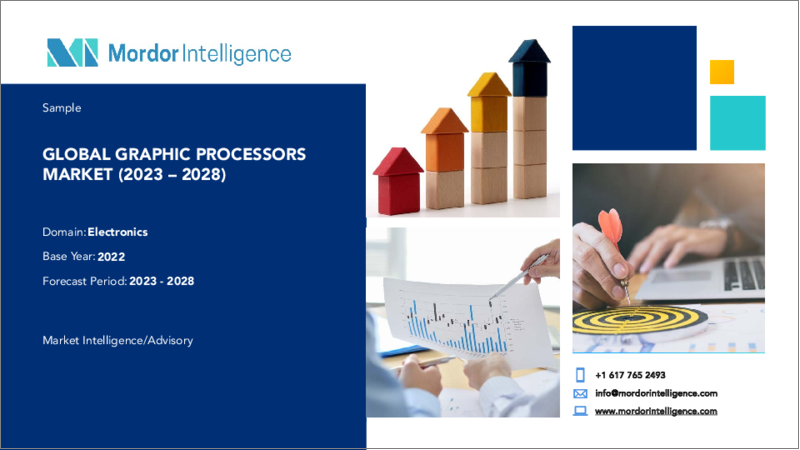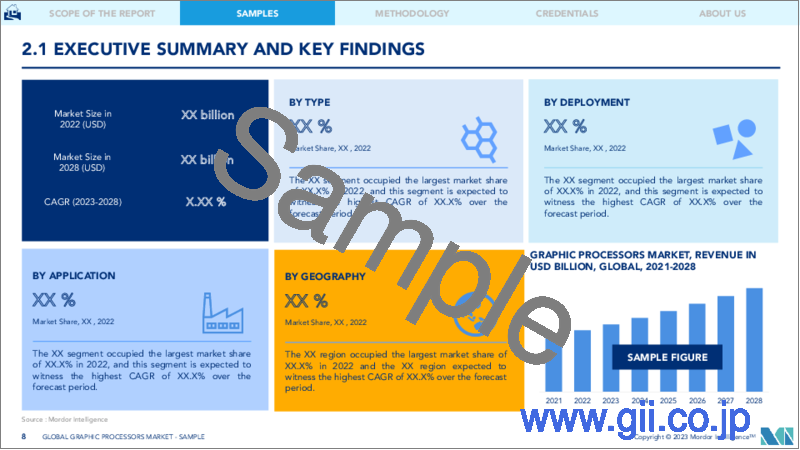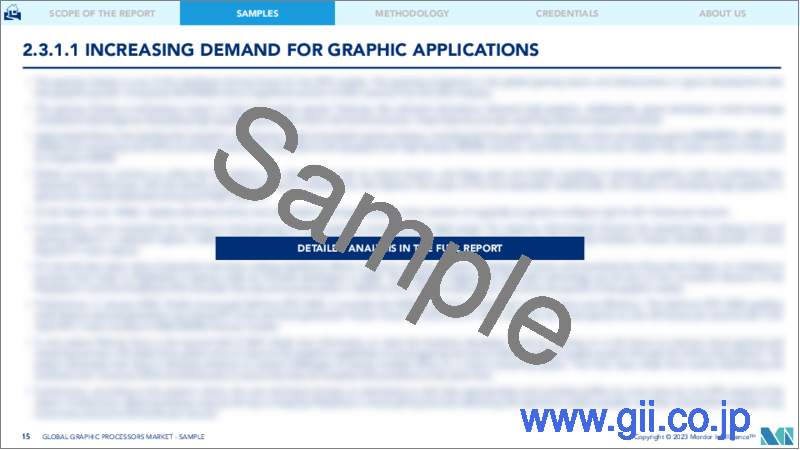|
|
市場調査レポート
商品コード
1197061
グラフィックプロセッサ市場- 成長、動向、予測(2023年-2028年)Graphic Processors Market - Growth, Trends, and Forecasts (2023 - 2028) |
||||||
|
● お客様のご希望に応じて、既存データの加工や未掲載情報(例:国別セグメント)の追加などの対応が可能です。 詳細はお問い合わせください。 |
|||||||
| グラフィックプロセッサ市場- 成長、動向、予測(2023年-2028年) |
|
出版日: 2023年01月23日
発行: Mordor Intelligence
ページ情報: 英文 131 Pages
納期: 2~3営業日
|
- 全表示
- 概要
- 目次
グラフィックプロセッサ市場は、予測期間中に33.35%のCAGRで推移すると予想されています。
ITAによると、米国のメディア&エンターテインメント産業は、来年までに8,250億米ドル以上に達すると予想されています。この産業の急成長により、ゲーム体験を向上させるために、ハイエンドのグラフィックスカードやプロセッサを搭載したデスクトップPCやタブレットの導入が進むと考えられます。
主なハイライト
- タブレット、スマートフォン、ノートブックへの消費者支出の増加により、ゲームアプリケーションの市場は拡大しており、高品質の視覚効果や高速ゲームアプリケーションを提供するグラフィックプロセッサの需要を牽引しています。
- グラフィックプロセッサ市場の成長を後押ししている要因は、製造、自動車、不動産、ヘルスケアなど、さまざまな業界におけるグラフィック・アプリケーションや3Dコンテンツをサポートするためのプロセッサの利用が増加していることです。例えば、自動車分野では、製造や設計のアプリケーションをサポートするために、CADやシミュレーション・ソフトウェアがGPUを活用してフォトリアリスティックな画像やアニメーションを作成しています。
- また、地理情報システム(GIS)や没入型マルチメディアの台頭も、グラフィックス処理市場を牽引しています。スマートフォンやタブレットなどのモバイルコンピューティングデバイスの普及により、リアルタイムの空間および地理データを提供するGISなどのアプリケーションの利用が増加しています。GISは、クエリーの生成、空間情報の分析、データのマッピング、出力などを行うことができます。しかし、リアルタイムな情報を提供するために、モバイルコンピューティングデバイスには大規模なグラフィックプロセッサが搭載されています。
- メタバースは、より高度な体験を提供します。現実の世界でできる多くの活動は、この現実世界の仮想的な表現でも可能です。プラットフォーム、アプリケーション、サービス間の相互運用性がエコシステムとして機能するために不可欠であるため、ソフトウェアはこれをサポートするために進歩する必要があります。ソフトウェアは異なる現実を融合するための重要な柱ですが、この新しいオンライン環境で人々が交流するためには、ハードウェアが不可欠です。
- フルボディ・ハプティクスやバーチャル・リアリティ機器がまだ利用可能であるため、移行期にはARやVR技術がメタバースを体験する主要な方法となるでしょう。このため、エレクトロニクス分野、特にGPUの観点からは、並列性を利用してデータ問題を解決しながら、ユーザーを没入させるためのイノベーションを広く先導する大きな可能性を持っています。
- また、システムの性能、効率、消費電力のバランスを適切に保つことができないことが、市場の成長にとって課題となります。さらに、ワークステーションの売上減少が、予測期間中のグラフィックプロセッサの市場成長の妨げになる可能性があります。
グラフィックプロセッサの市場動向
ゲーム産業が市場成長を促進
- ゲーム機器市場は、ハンドヘルド機器からタブレット、携帯電話、PC、ゲーム機、ゲームセンターまで、あらゆるプラットフォームに広がっており、巨大な市場となっています。ゲーム機は、ゲームセンターやレストラン、バーなどに設置された強力なロケーションベース機から、家庭用ゲーム専用機、マイコン、そしてPCへと進化してきました。
- ゲーム機には2種類のCPUが使用されています。ARM系とx86系の2種類です。ゲーム機は、ゲーム機、ノートPC、デスクトップPC、モバイル端末、そしてゲームセンター、レストラン、バー、アミューズメントパーク、カジノ、iCafe/ネットカフェなどにある各種ロケーションベース端末など、5つ以上のプラットフォームに分類されます。例えば、AMDはGPUをx86プロセッサーに統合し、アクセラレーテッド・プロセッサー・ユニットAPUと呼んでいます。
- 高性能なゲームといえば、ゲーミングノートPCの代名詞。彼らは、迅速なコマンドの実行と迅速な実行を可能にするので、迅速かつ効果的です。相対的な速度と全体的な性能に関して言えば、例えば、TitanクラスのカードであるNvidia GeForce RTX 3090は、非常に要求の厳しい性能を提供します。さらに、ゲーミングノートPCのグラフィックス設定を下げることなく、レイトレーシングとDLSSを格別にサポートします。
- しかし、Nvidiaは技術に大きく投資し、ゲーマーにカスタマイズ可能なソリューションを提供することも行っています。同社は、NvidiaのTuringアーキテクチャを採用し、130テラフロップスのディープラーニング性能と11ギガレイのレイトレーシング性能を実現する「Titan RTX」と題する強力なGPUを発表しました。GPUに新たに搭載されたディスプレイポートは、次世代VRヘッドセット用に設計されたもので、PCとの接続は1本で済むようになるそうです。
- さらに、ハードウェアの状況は常に流動的です。例えば、500~1500米ドルの価格帯の最新グラフィックカードは、AMDとNvidiaが成長中の1440pゲーム市場に向けてラインナップを一新し、完全に様変わりしました。Nvidiaの新しいフラッグシップモデル「RTX 3090 Ti」と比較すると、ラスターを多用するゲームでは最大2倍、完全レイトレース型のゲームでは最大4倍、RTX 4080は最大3倍高速なパフォーマンスが可能です。
- 仮想現実の復活やゲームへの拡張現実の導入により、ゲーム環境はさらに広がっています。例えば、Niantic Lab社の「Pokemon Go」のようなARゲームは位置情報ゲームであり、Googleマップを利用してポケモンのキャラクターが登場する神話の世界を拡張しています。ユーザーは、モバイル画面上で新しい路地を探検したり、隠れたキャラクターを探したりしますが、現実の世界では数キロメートル歩きます。
アジア太平洋地域が最速の成長市場に
- 中国、日本、シンガポール、インドなど、アジア太平洋地域の新興諸国は、高い需要が見込まれています。これは、モバイルコンピューティングデバイスの普及が進んでいることと、この地域のゲームアプリケーションの需要が高いことに起因すると思われます。
- 日本のゲーム市場は、いくつかのモバイルゲーム会社の継続的な成功により、世界第3位の規模を誇っています。日本のゲームユーザーは、他のどの国のプレーヤーよりも多くの金額を費やしています。日本のプレーヤー1人あたりの平均消費額は、西欧の約2.5倍、北米の約1.5倍となっています。
- 中国は、Biren TechnologyのBRシリーズを導入することで、独自のGPUコンピュートエンジンを開発しました。中国は、グラフィックスとコンピューティングのための専用のローカルGPUを利用できるようになり、GPU市場の熾烈な競争が激化することになります。
- 上海のチップメーカーである無錫は、ゲームに特化したGPUを発表することで、中国を世界地図に載せ、アジアの成長を促進することが期待されています。国内で拡大するハイエンドPCゲーム分野のニーズに対応するため、同社は中国独自のGPUを開発中とされています。ゲーム用に明示的に設計されたGPUは現在開発中で、2025年に発売されると予想されています。
- 監視や分析が必要な大量のデータを収集するIoTデバイスの普及に伴い、アジア太平洋地域の自動車分野では、ハイエンド・コンピューティング・システムの需要が事実上高まっています。
- さらに、中国、インド、日本、シンガポールなどの国々は、技術的な強化に向けてパラダイムをシフトしています。そのため、この地域では、スマートフォンやタブレットからプレイステーションやゲーミングPCに至るまで、スマートデバイスの売上が最も多くなっています。このような特性は、グラフィックプロセッサの需要が増加していることを説明しています。
グラフィックプロセッサ市場の競合分析
グラフィックプロセッサ市場は、主要プレイヤーが他のプレイヤーに対する競争力を得るために、製造技術の改善や製品ポートフォリオの拡大など、斬新な戦略を採用しているため、統合されています。主なプレイヤーは、Samsung Electronics、Qualcomm Incorporated、NVIDIA Corporation、Advanced Micro Devices Inc.、Intel Corporation、Taiwan Semiconductor Manufacturing Company Ltd、富士通株式会社、IBM Corporation、ソニー株式会社、Apple Inc.などとなっています。市場プレーヤーが採用した開発戦略の一部をご紹介します。
- 2022年9月、NVIDIAから新しいGeForce RTX GPUと技術が発表されました。NVIDIAのGeForce RTX 40シリーズグラフィックスカードは非常に高速で、ゲーマーやクリエイターにパフォーマンスの飛躍的向上、AI搭載グラフィックス、より没入感のあるゲームプレイ、最速のコンテンツ作成ワークフローを提供します。最新のゲームでは、ゲーム性能が2倍に向上しています。DLSS 3やその他のAdaの開発を活用することで、開発者は完全にレイトレースされたゲームのパフォーマンスを最大4倍まで向上させることができます。GeForce RTX 40シリーズグラフィックスカードは、3Dレンダリング、ビデオのエクスポート速度、クリエイティブアプリ向けのAI機能において、最大2倍のパフォーマンスを提供します。
- 2022年11月、AMD Radeon RX AMDは、7900 XTとRadeon RX 7900 XTグラフィックスカードを発表しました。これらは、最新の高性能でエネルギー効率に優れたAMD RDNA 3アーキテクチャをベースにしています。この新しいグラフィックカードは、大人気のAMD「Zen」ベースのAMD Ryzenチップセット・プロセッサに続き、世界で初めて革新的なAMDチップセット・デザインを搭載したゲーミング・グラフィックカードです。これらの製品は、卓越したパフォーマンスと優れたエネルギー効率を提供し、最も要求の厳しいタイトルでも高フレームレートの4Kおよびそれ以上の解像度のゲームを可能にします。
その他の特典
- エクセル形式の市場予測(ME)シート
- アナリストによる3ヶ月間のサポート
目次
第1章 イントロダクション
- 調査の成果 と市場想定
- 調査対象範囲
第2章 調査手法
第3章 エグゼクティブサマリー
第4章 市場力学
- 市場概要
- 市場促進要因と抑制要因のイントロダクション
- 市場促進要因
- グラフィックアプリケーションの需要拡大
- 地理情報システム(GIS)とイマーシブマルチメディアの台頭
- 市場抑制要因
- ワークステーションの販売減少
- 産業バリューチェーン分析
- 業界の魅力- ポーターのファイブフォース分析
- 買い手/消費者の交渉力
- 供給企業の交渉力
- 新規参入業者の脅威
- 代替品の脅威
- 競争企業間の敵対関係
第5章 市場セグメンテーション
- タイプ別
- 専用グラフィックスカード
- 統合グラフィックスソリューション
- ハイブリッドソリューション
- 導入形態別
- オンプレミス
- クラウド
- アプリケーション別
- スマートフォン
- タブレット・ノートPC
- ワークステーション
- ゲーミングPC
- メディア・エンターテインメント
- オートモーティブ
- 地域別
- 北米
- 欧州
- アジア太平洋地域
- ラテンアメリカ
- 中東
第6章 競合情勢
- 企業プロファイル
- Samsung Electronics Co. Ltd
- Qualcomm Incorporated
- NVIDIA Corporation
- Advanced Micro Devices Inc.
- Intel Corporation
- Taiwan Semiconductor Manufacturing Company Ltd
- Fujitsu Ltd
- IBM Corporation
- Sony Corporation
- Apple Inc.
第7章 投資分析
第8章 市場機会と将来動向
The graphic processors market is expected to register a CAGR of 33.35% over the forecast period. According to the ITA, the United States media & entertainment industry is expected to reach more than USD 825 billion by next year. The industry's rapid growth will trigger the adoption of desk-based PCs and tablets with high-end graphics cards and processors to enhance the gaming experience.
Key Highlights
- The market for gaming applications is rising due to increased consumer spending on tablets, smartphones, and notebooks, driving the demand for graphics processors to provide high-quality visual effects and high-speed gaming applications.
- The factor fueling the graphic processor market's growth is the increasing usage of processors to support graphics applications and 3D content in various industry verticals such as manufacturing, automotive, real estate, and healthcare. For instance, to support manufacturing and design applications in the automotive sector, CAD and simulation software leverages GPUs to create photorealistic images or animations.
- The rise of geographic information systems (GIS) and immersive multimedia are also driving the graphics processing market. Increasing usage of applications such as GIS that provide real-time spatial and geographical data is rising owing to the penetration of smartphones, tablets, and other mobile computing devices. A GIS allows users to generate a query, analyze spatial information, map data, and provide output. However, to provide real-time information, mobile computing devices incorporate graphic processors on a large scale.
- The metaverse offers an enhanced experience. Many activities people can perform in the real world are also possible in this virtual representation of the real world. The software will need to advance to support this because interoperability between platforms, applications, and services will be essential for a working ecosystem. Hardware will be essential to allow people to interact with this new online environment, despite software being an important pillar in the convergence of different realities.
- With full-body haptics and virtual reality equipment still available, AR and VR technologies will likely be the primary ways of experiencing the metaverse during the transition. This offers enormous potential for the electronics sector, particularly from the perspective of GPUs, to spearhead widespread innovation that will aid in immersing users while utilizing parallelism to address data issues.
- Moreover, the inability to properly balance system performance, efficiency, and power consumption poses a challenge to market growth. Further, declining workstation sales may hamper the graphic processors' market growth over the forecast period.
Graphic Processors Market Trends
Gaming Industry to Augment Market Growth
- The gaming hardware market is huge, spreading across all platforms, from handheld devices to tablets, phones, PCs, consoles, location-based arcades, and gaming parlors. Gaming machines evolved from powerful location-based machines found in arcades, restaurants, and bars to in-home machines in the form of dedicated gaming consoles, microcomputers, and then PCs.
- Gaming machines use two types of CPU processors: ARM and x86-based machines. Those machines fall into five or more platforms, including consoles, notebooks, desktops, mobile devices, and various types of location-based devices found in arcades, restaurants, bars, amusement parks, casinos, and iCafe/net cafes. For instance, AMD integrates a GPU into an x86 processor and calls it an accelerated processor unit APU.
- High-performance gaming is synonymous with gaming laptops. They enable quicker command execution and swift running since they are quick and effective. When it comes to relative speeds and overall performances, for instance, the Nvidia GeForce RTX 3090, a Titan class card, offers highly demanding performance. Additionally, it supports Ray Tracing and DLSS exceptionally well without reducing the graphics settings on the gaming laptop.
- However, Nvidia is also investing significantly in technology and offering gamers customizable solutions. The company announced its powerful GPU, titled Titan RTX, which uses Nvidia's Turing architecture and delivers 130 teraflops of deep learning performance and 11 gigarays of ray-tracing performance. The new display port on the GPU is designed for next-generation VR headsets, which will only need one wire to connect to PCs.
- Moreover, the hardware landscape is constantly in flux. For instance, the latest graphics cards in the USD 500-USD 1500 price range completely changed, with AMD and Nvidia overhauling their lineups for the growing 1440p gaming market. Compared to the previous flagship RTX 3090 Ti, Nvidia's new flagship RTX 4090 can perform up to two times better in raster-heavy games and up to four times quicker in fully ray-traced games, while the RTX 4080 will be up to three times faster.
- The gaming environment has been further expanded with the resurrection of virtual reality and the introduction of augmented reality for gaming. For instance, AR games like Niantic Lab's Pokemon Go are location-based games and use Google Maps to augment a mythical world filled with characters from the Pokemon. Users are encouraged to explore new alleys or hunt for hidden characters on their mobile screens; in the real world, they walk several miles.
Asia-Pacific to be Fastest-Growing Market
- Developing countries in the Asia Pacific, such as China, Japan, Singapore, and India, are expected to witness high demand. This may be attributed to the increasing adoption of mobile computing devices and the region's high demand for gaming applications.
- The Japanese gaming market is the third-largest in the world due to the continued success of several mobile gaming companies in the country. Japanese gamers spend more than players in any other country. The average spending per Japanese player is approximately 2.5 times higher than that in western Europe and nearly 1.5 times higher than in North America.
- China developed its own GPU compute engines by introducing the BR series of products from Biren Technology. China now has access to a dedicated local GPU for graphics and computing, which will intensify the fierce GPU market competition.
- With its upcoming game-focused GPUs, Shanghai-based chipmaker Muxi is anticipated to put China on the global map and promote Asia's growth. In order to meet the needs of the expanding high-end PC gaming sector in the nation, the company is reportedly creating China's in-house GPU. The GPU explicitly designed for gaming is currently under development and is anticipated to be available in 2025.
- With the growing adoption of IoT devices that gather huge amounts of data that needs to be monitored and analyzed, the demand for high-end computing systems has effectively increased in the automotive sector in the Asia-Pacific Region.
- Moreover, countries such as China, India, Japan, and Singapore are shifting the paradigm toward technological enhancement. Therefore, the region has the highest smart device sales, from smartphones and tablets to PlayStation and gaming PCs. This attribute explains the increasing demand for graphics processors.
Graphic Processors Market Competitor Analysis
The graphic processors market is consolidated due to major market players adopting novel strategies to improve manufacturing techniques and widen their product portfolios to gain a competitive edge over other market players. The major players in the market are Samsung Electronics Co. Ltd, Qualcomm Incorporated, NVIDIA Corporation, Advanced Micro Devices Inc., Intel Corporation, Taiwan Semiconductor Manufacturing Company Ltd, Fujitsu Ltd, IBM Corporation, Sony Corporation, and Apple Inc., among others. Some developmental strategies adopted by market players are:
- In September 2022, new GeForce RTX GPUs and technologies were launched by NVIDIA. The GeForce RTX 40 Series graphics cards from NVIDIA are so fast that they provide gamers and creators with a quantum leap in performance, AI-powered graphics, more immersive gameplay, and the quickest content creation workflows. The newest games have a 2X increase in gaming performance. By utilizing DLSS 3 and other Ada developments, developers can increase performance in fully ray-traced games by up to a 4X increase. The GeForce RTX 40 Series graphics cards offer up to two times as much performance in 3D rendering, video export speed, and AI features for creative apps.
- In November 2022, The AMD Radeon RX AMD introduced 7900 XT and Radeon RX 7900 XT graphics cards. They are based on the newest, high-performance, energy-efficient AMD RDNA 3 architecture. The new graphics cards are the first gaming graphics cards in the world to include an innovative AMD chipset design, following the hugely popular AMD "Zen"-based AMD Ryzen chipset processors. They provide exceptional performance and superb energy efficiency to enable high-framerate 4K and greater resolution gaming in the most demanding titles.
Additional Benefits:
- The market estimate (ME) sheet in Excel format
- 3 months of analyst support
TABLE OF CONTENTS
1 INTRODUCTION
- 1.1 Study Deliverables and Market Assumptions
- 1.2 Scope of the Study
2 RESEARCH METHODOLOGY
3 EXECUTIVE SUMMARY
4 MARKET DYNAMICS
- 4.1 Market Overview
- 4.2 Introduction to Market Drivers and Restraints
- 4.3 Market Drivers
- 4.3.1 Increasing Demand for Graphic Applications
- 4.3.2 Rise of Geographic Information Systems (GIS) and Immersive Multimedia
- 4.4 Market Restraints
- 4.4.1 Declining Workstation Sales
- 4.5 Industry Value Chain Analysis
- 4.6 Industry Attractiveness - Porter's Five Force Analysis
- 4.6.1 Bargaining Power of Buyers/Consumers
- 4.6.2 Bargaining Power of Suppliers
- 4.6.3 Threat of New Entrants
- 4.6.4 Threat of Substitute Products
- 4.6.5 Intensity of Competitive Rivalry
5 MARKET SEGMENTATION
- 5.1 By Type
- 5.1.1 Dedicated Graphics Card
- 5.1.2 Integrated Graphics Solutions
- 5.1.3 Hybrid Solutions
- 5.2 By Deployement
- 5.2.1 On-premise
- 5.2.2 Cloud
- 5.3 By Applications
- 5.3.1 Smartphones
- 5.3.2 Tablets and Notebooks
- 5.3.3 Workstations
- 5.3.4 Gaming PC
- 5.3.5 Media and Entertainment
- 5.3.6 Automotives
- 5.4 Geography
- 5.4.1 North America
- 5.4.2 Europe
- 5.4.3 Asia-Pacific
- 5.4.4 Latin America
- 5.4.5 Middle East
6 COMPETITIVE LANDSCAPE
- 6.1 Company Profiles
- 6.1.1 Samsung Electronics Co. Ltd
- 6.1.2 Qualcomm Incorporated
- 6.1.3 NVIDIA Corporation
- 6.1.4 Advanced Micro Devices Inc.
- 6.1.5 Intel Corporation
- 6.1.6 Taiwan Semiconductor Manufacturing Company Ltd
- 6.1.7 Fujitsu Ltd
- 6.1.8 IBM Corporation
- 6.1.9 Sony Corporation
- 6.1.10 Apple Inc.




